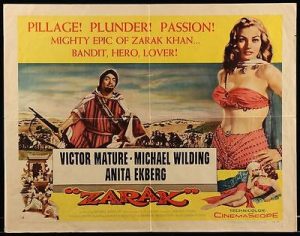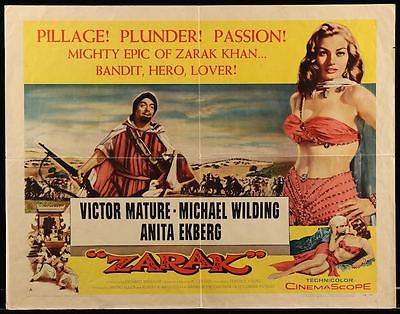
This desert-set adventure flick exemplifies the subtle difference between Hokum and Camp: recently, I had watched its star, Victor Mature, in THE VEILS OF BAGDAD (1953) spirited, tongue-in-cheek and generally exuding an air of unpretentious low-budget professionalism, it falls firmly into the former category; ZARAK, on the other hand, tries to be serious (with its religious/political undertones and calling into question familial/patriotic loyalties at times of stress) but is so relentlessly high-strung as to emerge a fount of virtually uninterrupted (but clearly unintended) hilarity!
These are too numerous to cite and most have, in any case already subsided in my memory, but I can’t fail to mention Mature’s irrepressible resourcefulness though very obviously doubled at times when aroused (including high-kicking his opponents and vigorously hacking away at a rope-bridge on which his arch-nemesis Michael Wilding is hanging for dear life), stoicism in the face of torture and impending death and, particularly, his wallowing in self-pity (and hysterically funny subsequent haunting) after unwittingly bludgeoning to death the current Mullah of the mosque who had actually interceded for Mature during a public flogging and does the same, much to the latter’s evident chagrin, for the British Major at the aforementioned bridge sequence! That is not to say ZARAK is a bad film in the strict sense of the word: for one thing, there’s plenty of action throughout (some of it actually borrowed from the classic Alexander Korda production of THE FOUR FEATHERS [1939]!) but, to be sure, the narrative is inordinately muddled for this type of film (not only in delineating the plot or the hero’s motivations, but also by having such a prominent character as that of Bernard Miles vanish altogether halfway through)!
This was the second of six British-made actioners featuring Hollywood hunk Mature, filmed virtually back-to-back and after which his career would slowly grind to a stand-still; for the record, the others none of which I’ve watched were SAFARI (1956), INTERPOL (1957; also with co-star Anita Ekberg), THE LONG HAUL (1957), NO TIME TO DIE (1958) and the somewhat similar THE BANDIT OF ZHOBE (1959; actually directed by the co-story writer of this one, John Gilling). Sexy in scantily-clad attire, Ekberg even gets to perform a sultry exotic dance but is otherwise underused here; Wilding is as ineffectual playing the stiff-upper-lipped cavalry officer after Mature as the latter is wooden in Afghan tinge and garb(!), Miles appears as the star’s one-eyed comic relief sidekick (at one point drooling over the heroine’s writhing and to which he’s vainly attempting to draw his brooding partner’s attention), while Finlay Currie is what else? the earnest but ill-fated Holy Man. Apart from these, the supporting cast includes: Bonar Colleano (as one of Zarak’s treacherous younger siblings), Frederick Valk (in his last role as his tyrannical father), Eunice Gayson (best-known for first eliciting the celebrated trademark response of “Bond, James Bond” in DR. NO [1962], of course is here Wilding’s ingenuous bride) and Patrick McGoohan (youthful but already imposing in what is presumably his first sizeable part in a film as Wilding’s aide). The behind-the-scenes credits are similarly notable several of whom would soon prove instrumental in cementing the 007 image into the public consciousness.

